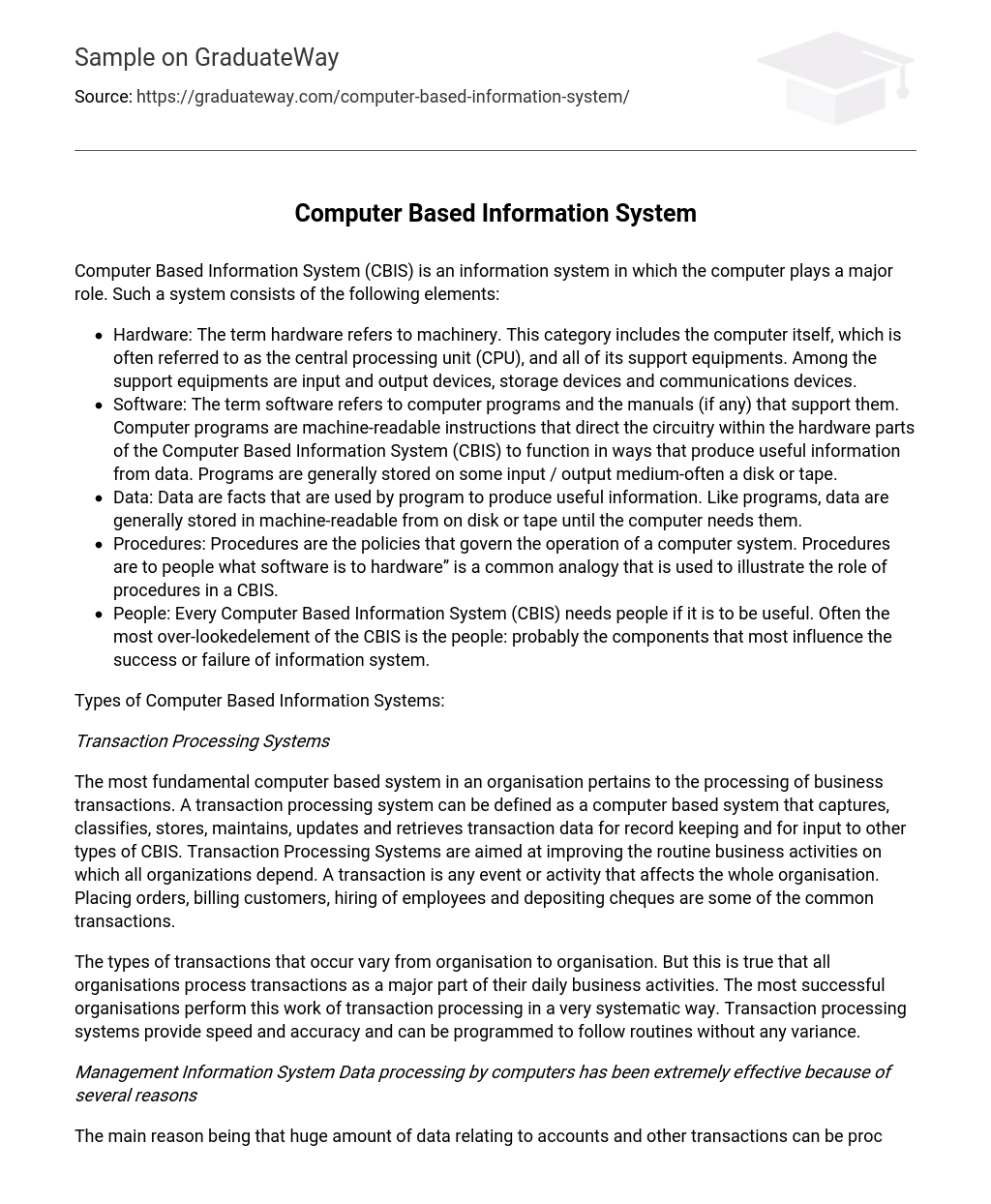Computer Based Information System (CBIS) is an information system in which the computer plays a major role. Such a system consists of the following elements:
- Hardware: The term hardware refers to machinery. This category includes the computer itself, which is often referred to as the central processing unit (CPU), and all of its support equipments. Among the support equipments are input and output devices, storage devices and communications devices.
- Software: The term software refers to computer programs and the manuals (if any) that support them. Computer programs are machine-readable instructions that direct the circuitry within the hardware parts of the Computer Based Information System (CBIS) to function in ways that produce useful information from data. Programs are generally stored on some input / output medium-often a disk or tape.
- Data: Data are facts that are used by program to produce useful information. Like programs, data are generally stored in machine-readable from on disk or tape until the computer needs them.
- Procedures: Procedures are the policies that govern the operation of a computer system. Procedures are to people what software is to hardware” is a common analogy that is used to illustrate the role of procedures in a CBIS.
- People: Every Computer Based Information System (CBIS) needs people if it is to be useful. Often the most over-lookedelement of the CBIS is the people: probably the components that most influence the success or failure of information system.
Types of Computer Based Information Systems:
Transaction Processing Systems
The most fundamental computer based system in an organisation pertains to the processing of business transactions. A transaction processing system can be defined as a computer based system that captures, classifies, stores, maintains, updates and retrieves transaction data for record keeping and for input to other types of CBIS. Transaction Processing Systems are aimed at improving the routine business activities on which all organizations depend. A transaction is any event or activity that affects the whole organisation. Placing orders, billing customers, hiring of employees and depositing cheques are some of the common transactions.
The types of transactions that occur vary from organisation to organisation. But this is true that all organisations process transactions as a major part of their daily business activities. The most successful organisations perform this work of transaction processing in a very systematic way. Transaction processing systems provide speed and accuracy and can be programmed to follow routines without any variance.
Management Information System Data processing by computers has been extremely effective because of several reasons
The main reason being that huge amount of data relating to accounts and other transactions can be processed very quickly. Earlier most of the computer applications were concerned with record keeping and the automation of routine clerical processes. However, in recent years, increasing attention has been focussed on computer applications providing information for policy making, management planning and control purposes. MIS are more concerned with management function. MIS can be described as information system that can provide all levels of management with information essential to the running of smooth business.
Decision Support Systems
It is an information system that offers the kind of information that may not be predictable, the kind that business professionals may need only once. These systems do not produce regularly scheduled management reports. Instead, they are designed to respond to a wide range of requests. It is true that all the decisions in an organisation are not of a recurring nature.
Decision support systems assist managers who must make decisions that are not highly structured, often called unstructured or semi-structured decisions. A decision is considered unstructured if there are no clear procedures for making the decision and if not all the factors to be considered in the decision can be readily identified in advance. Judgement of the manager plays a vital role in decision making where the problem is not structured. The decision support system supports, but does not replace, judgement of manager.
Office Automation Systems
Office automation systems are among the newest and most rapidly expanding computer based information systems. They are being developed with the hopes and expectations that they will increase the efficiency and productivity of office workers-typists, secretaries, administrative assistants, staff professionals, managers and the like. Many organisations have taken the First step toward automating their offices. Often this step involves the use of word processing equipment to facilitate the typing, storing, revising and printing of textual materials.
Another development is a computer based communications system such as electronic mail which allows people to communicate in an electronic mode through computer terminals. An office automation system can be described as a multi-function, integrated computer based system that allows many office activities to be performed in an electronic mode.





